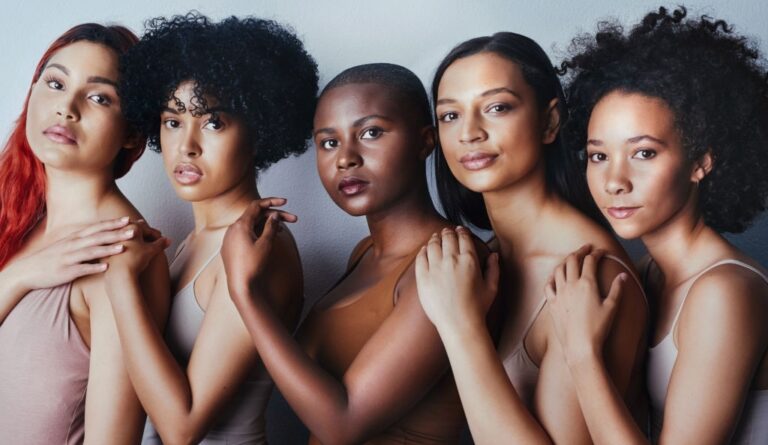The ‘skin of color’ covers a wide range of ethnic minorities and skin tones from African Americans to South Asians. But what gives color to our skin? Melanin is the unique natural pigment (from the amino acid tyrosinase) found in the skin which determines the color. Skin cells melanocytes make melanin, but some people produce more melanin than others; which brings us back to the skin of color- we create more melanin! Which increases pigment giving us beautiful dark rich complexions.
Skin Struggles
Which rich complexion ethnic background are you from? Let us know below!
Of course, different ethnicities vary with the amount of melanin they produce, however, some of the most common issues rich complexions may struggle with include:
- Possible for more stubborn hyperpigmentation, including blemishes, breakouts, uneven skin tone, dark marks and raised scarring.
- A tendency for dark circles due to high melanin content around the eye region.
- When unprotected skin exposure affects the skin, including hyperpigmentation, inflammation and cellular damage.
- Less volume of ceramides naturally present in our skin, which keeps the superficial layer hydrated and smooth.
- Susceptible skin conditions such as melasma, vitiligo, keloids, psoriasis, eczema, acanthosis nigricans and dermatitis.
Preventative Methods
Do you struggle or have struggled with any of these issues? Share your experience below!
As women and men of color, we must strive and practice to maintain healthy skin. Even with skin struggles as mentioned above, there are many methods to help prevent, protect and treat our rich complexions. This includes:
- (Hyperpigmentation) Superstar ingredients specifically Azelaic acid: which can target uneven skin tone. Various types of vitamin C, bakuchiol, retinol, arbutin niacinamide and tranexamic acid have substantiated research on their tone-evening and skin brightening capabilities. Regardless of the tone of your skin… sun protection is essential to protect and prevent.
- (Dark circles) Always wear sunglasses outdoors, layering brightening products such as ascorbic acid (vitamin C) or niacinamide (vitamin B3). A high concentration of azelaic acid to soften the darkness. And the most important; topping up sun protection to protect against UV damage.
- (UV exposed skin) While melanin-rich skin naturally offers more protection from sun damage than lighter skin, that does not mean sunscreen is optional. Rich complexions are at the same risk from sun exposure including wrinkles and mainly hyperpigmentation. It just may take a little longer to show up due to how our skin is built. We must apply SPF every single day, indoors and outdoors.
- (Ceramide hydration) A moisturizer that is rich in ceramides to directly hydrate and soften the skin as well as incorporating plant oils such as jojoba or olive. Did you know rich complexions contains lower levels of ceramides? This is why we must restore this back into our skin to prevent dryness which can often turn into dark patches.
- (Skin conditions) These are personal and sensitive. Each condition has their unique ways and needs in getting better (advised by your dermatologist or doctor). However, there is one vital product to ensure protection and preventing more damage. That is sun protection…
Sun Protection Factor
Did you know rich complexions have a natural sun protection factor of up to 13 and filter twice as much as UV radiation than fair skin? Let us not get too excited now…we still need to protect our melanin from hyperpigmentation-the biggest struggle to battle. No one is immune to the damaging effects of the sun. Skin of color will still burn, destroying cells and are still susceptible to sun-induced damage including sun spots, hyperpigmentation, wrinkles and skin cancer. Rich complexions are more prone to getting skin cancer, especially on skin conditions that are sun-sensitive- for instance: lupus and using medication will increase skins sensitivity to light, increasing UV damage.
Do you use SPF on your skin? It is high time we start practising SPF in our daily routine. It is really about maintaining healthy skin for life. Protecting our melanin. Preserving our pigment. And most of all, preventing the increase of hyperpigmentation. Did you know an SPF 30 blocks around 97% of UVB radiation, SPF 50 blocks about 98% and SPF 100 blocks about 99%?
Hyperpigmentation
So what difference does it make if we use SPF daily? When sun protection is present on the skin it creates a protective barrier between your skin and radiation. When your protected skin is exposed outside or inside, the UVA (Ultraviolet A) and UVB (Ultraviolet B) rays bounce off your skin, protecting it from the damages of hyperpigmentation. This works by the presence of the substances zinc oxide and titanium dioxide and avobenzone if you prefer a non-chalky residue- the powerhouse ingredients to block or absorb UV rays. Besides, it will help slow down tyrosinase production in the skin to prevent darkening of any skin area.
Dr Susan C Taylor (M.D.) referred to a study published in 1983- which researchers studied 53 melasma patients. One group used an SPF and the other a placebo. There was a significant difference in the improvement of melasma. In the group that used (4% hydroquinone and) sunscreen, a whopping 96% improves. Whereas the placebo group without the sunscreen, only 80%. This proves the positive role in sun protection!
Rich complexions stay winning!
Overall, as expressed, rich complexions must be treasured and protected at all costs! We’re lucky enough to have at least 13 natural protection factor in our skin, but it’s not enough. An SPF is a bulletproof weapon to keep our skin from facing skin damage and increased hyperpigmentation.
Let’s embrace healthy rich complexions protected by SPF!
What do you think? Share your thoughts below!



